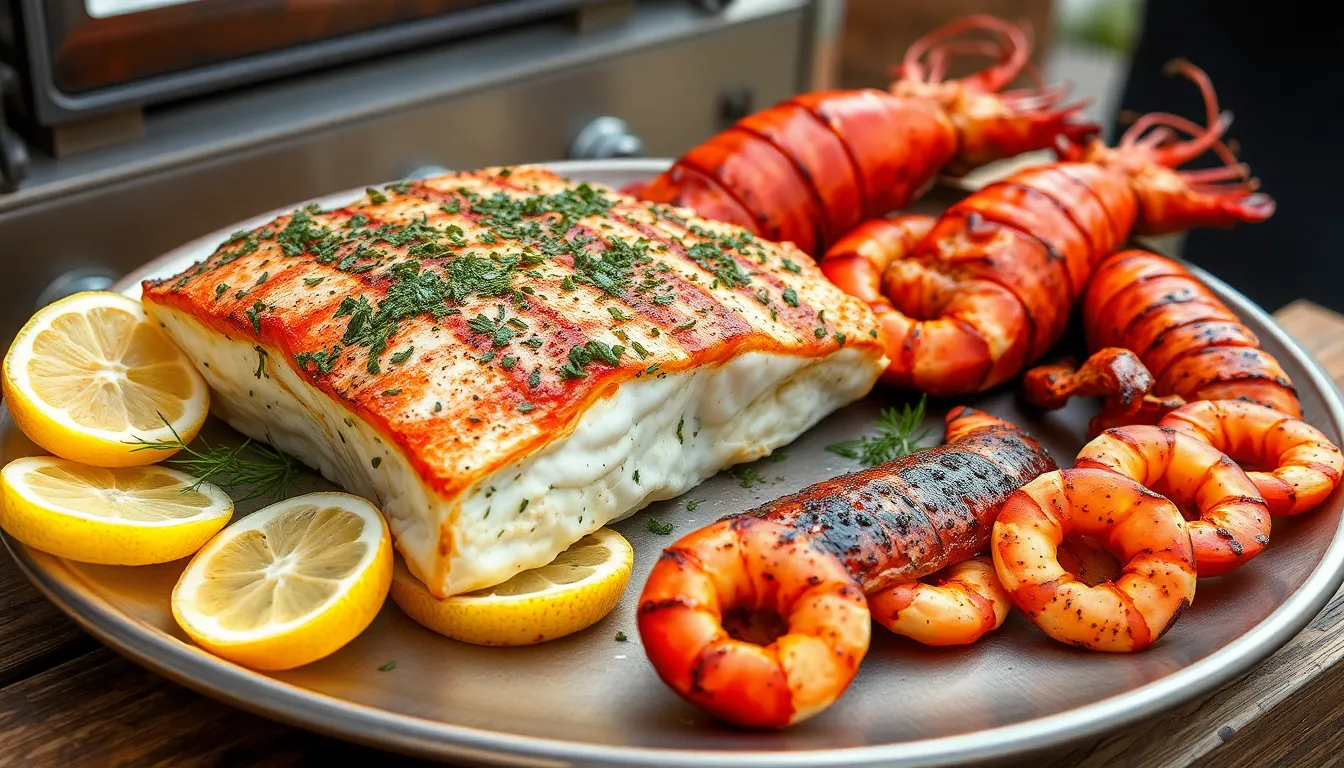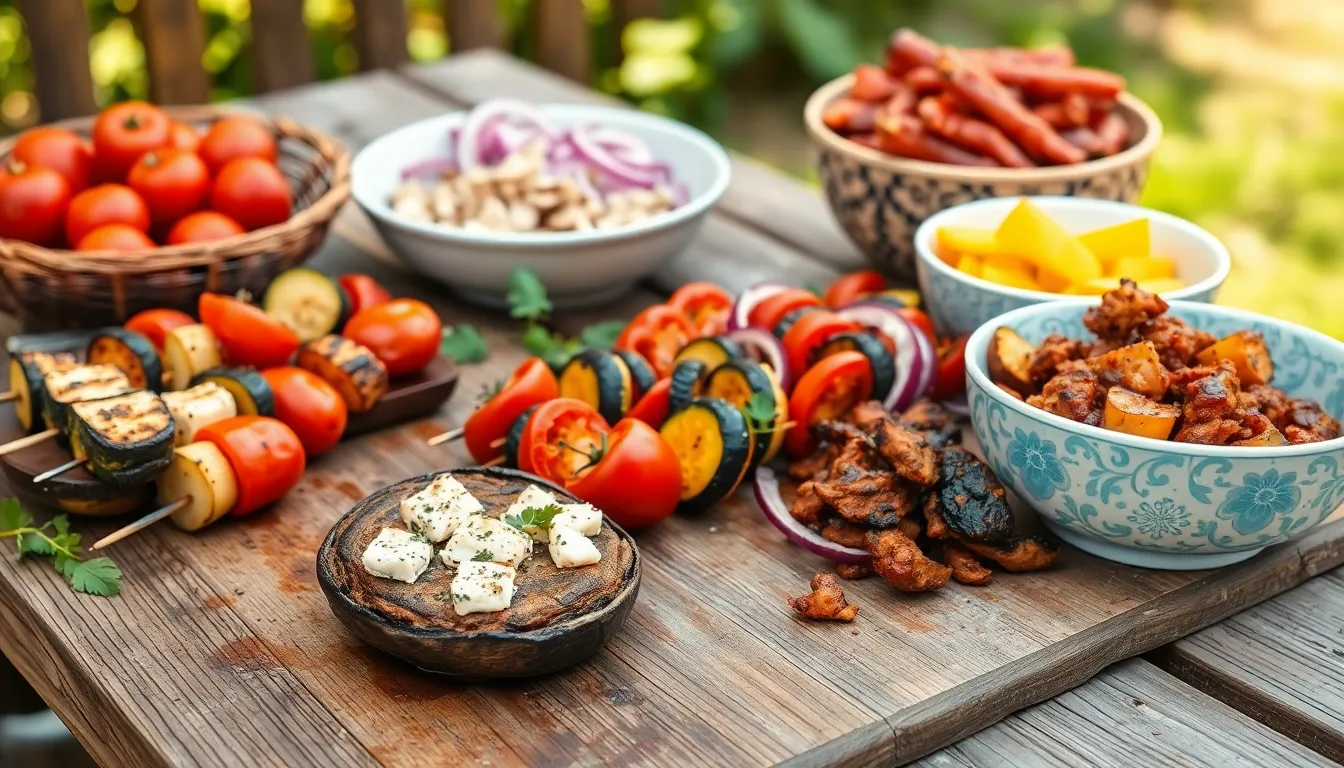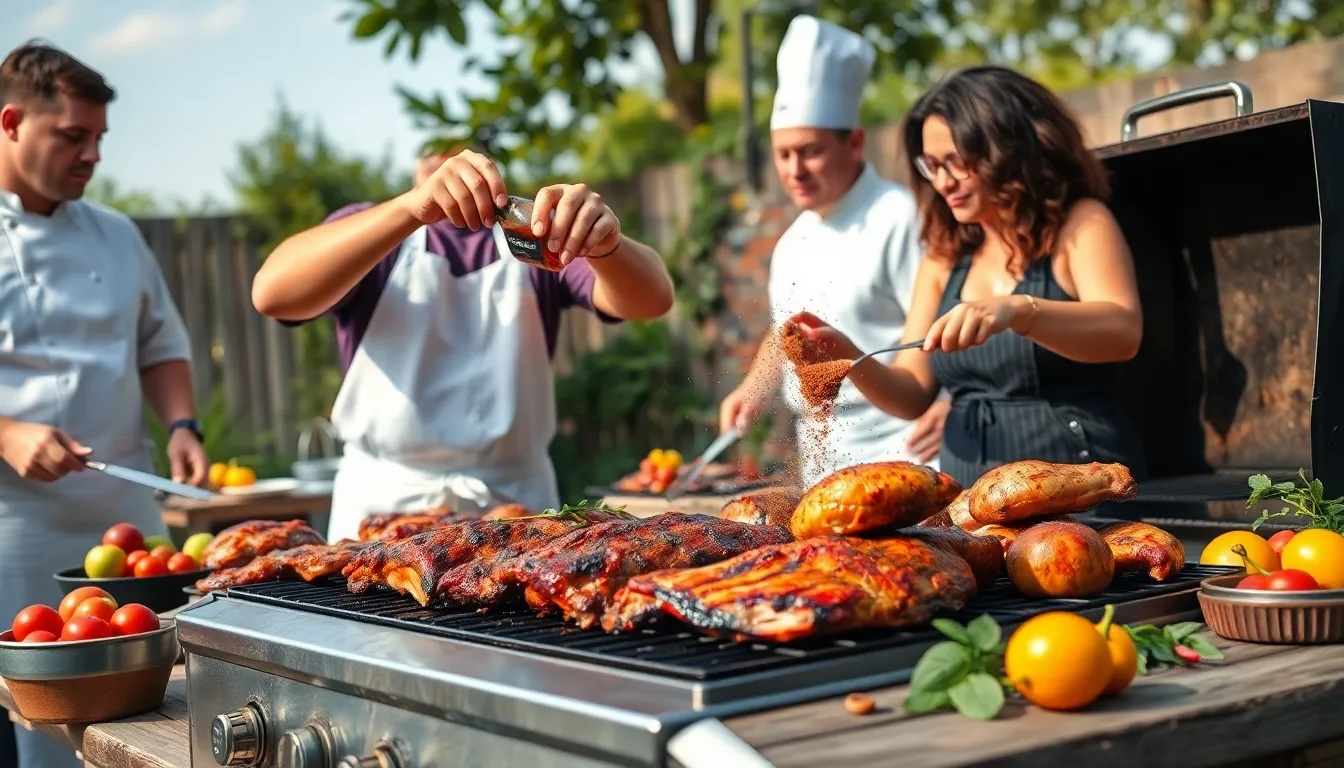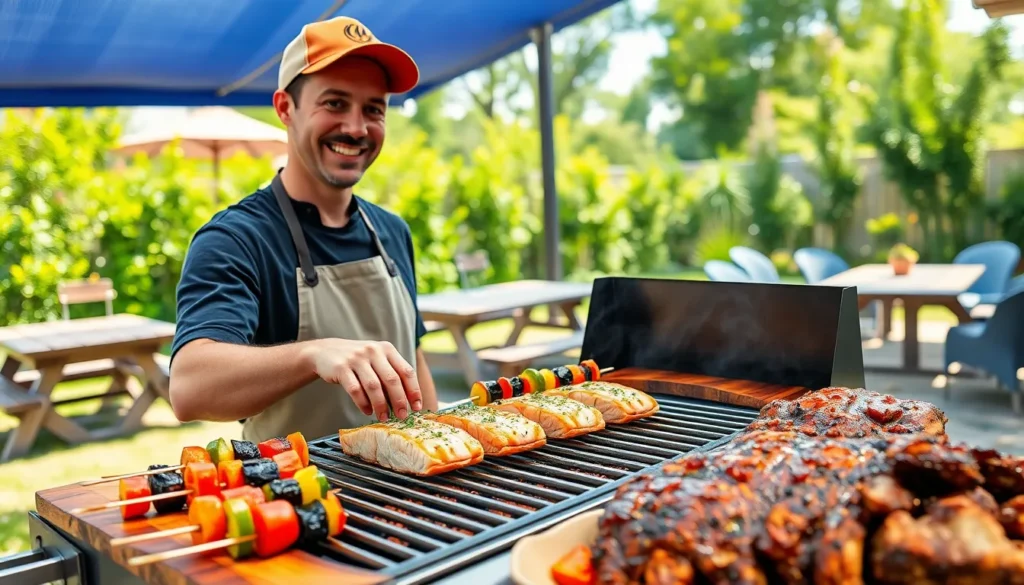When it comes to elevating your backyard barbecue game, we know the secret isn’t just in the sauce – it’s in the chef’s choice selections that transform ordinary cookouts into unforgettable culinary experiences. Whether you’re a weekend warrior at the grill or someone who lives and breathes barbecue, we’ve discovered that the best BBQ ideas often come from thinking beyond traditional burgers and hot dogs.
We’ve spent countless hours perfecting techniques and experimenting with flavor combinations that’ll make your neighbors peek over the fence in curiosity. From premium cuts that deserve special treatment to creative marinades and rubs that pack serious punch, the right chef’s choice approach can turn your grill into the neighborhood’s hottest destination.
Ready to discover BBQ ideas that’ll have everyone asking for your secrets? We’re about to share the game-changing techniques and mouth-watering recipes that separate amateur grillers from true barbecue champions.
Classic BBQ Meats That Define Chef’s Choice Excellence
These time-tested barbecue staples form the foundation of exceptional chef’s choice menus. Mastering these classic cuts transforms any backyard gathering into a professional-level culinary experience.
Perfectly Smoked Brisket Techniques
Brisket stands as the ultimate test of barbecue mastery, requiring patience and precision to achieve that coveted smoke ring. We recommend selecting a whole packer brisket weighing 12-16 pounds for optimal results. Season the meat 12-24 hours before cooking with a simple rub of kosher salt, black pepper, and garlic powder.
Temperature control becomes critical when smoking brisket, maintaining a steady 225°F throughout the cooking process. Expect cooking times of 1-1.5 hours per pound, wrapping the brisket in butcher paper once it reaches 165°F internal temperature. This technique, known as the Texas Crutch, helps push through the stall while maintaining bark integrity.
Monitoring internal temperature ensures perfect doneness, targeting 203-205°F in the thickest part of the flat. Rest the finished brisket for at least 1 hour before slicing against the grain into pencil-thick slices.
Fall-Off-The-Bone Ribs Mastery
Ribs deliver consistent crowd-pleasing results when prepared using the 3-2-1 method for spare ribs or 2-2-1 for baby backs. Start by removing the membrane from the bone side using a paper towel for better grip. Apply your favorite dry rub generously, covering all surfaces including the ends.
Smoke the ribs meat-side up at 225°F for the initial cooking phase, allowing the rub to form a beautiful bark. Wrap the ribs in aluminum foil with butter, brown sugar, and apple juice during the braising phase to tenderize the meat. Finish unwrapped to restore the bark texture and apply barbecue sauce if desired.
Test for doneness using the bend test: lift the rack with tongs from one end, and properly cooked ribs will crack slightly on the surface. Internal temperature should reach 195-203°F between the bones for optimal tenderness.
Juicy Pulled Pork Perfection
Pork shoulder, also called Boston butt, provides the most forgiving cut for beginners while delivering exceptional flavor when done right. Choose bone-in shoulders weighing 8-10 pounds for better moisture retention and enhanced taste. Trim excess fat cap to about 1/4 inch thickness to allow proper seasoning penetration.
Create a balanced rub combining brown sugar, paprika, garlic powder, onion powder, and cayenne pepper for complexity. Apply the rub 4-8 hours before cooking, allowing the salt to penetrate the meat fibers. Inject the shoulder with apple juice or broth for added moisture if desired.
Maintain cooking temperature at 225-250°F, planning for 1.5 hours per pound cooking time. Wrap in foil when the internal temperature stalls around 160°F to accelerate cooking. Target final internal temperature of 203-205°F for easy shredding. Rest the cooked pork for 30 minutes before pulling with forks or bear claws, mixing in accumulated juices for maximum flavor.
Elevated Seafood BBQ Ideas for Gourmet Grilling

Moving beyond traditional land based proteins opens up exciting opportunities for sophisticated grilling adventures. We’re diving into premium seafood preparations that’ll transform your BBQ into a high end culinary experience.
Cedar Plank Salmon with Herb Crusts
Cedar plank grilling delivers the perfect combination of smoky flavor and moist texture for salmon fillets. We recommend soaking your cedar plank for at least 2 hours before grilling to prevent burning and maximize that signature woody aroma.
Fresh herb crusts elevate this classic technique with combinations of parsley, dill, thyme, and lemon zest mixed with breadcrumbs or Dijon mustard. The plank method prevents sticking while keeping the fish incredibly tender throughout the cooking process.
Temperature control becomes crucial here since we’re aiming for that perfect flaky texture without overcooking. Set your grill to medium heat around 350°F and expect cooking times of 12 to 15 minutes depending on fillet thickness.
Grilled Lobster Tails with Garlic Butter
Lobster tails bring restaurant quality elegance to any backyard gathering with minimal preparation required. We split the shells down the middle and grill them over high heat for quick searing that preserves the delicate meat texture.
Garlic butter preparation starts with melted butter, minced fresh garlic, lemon juice, and chopped parsley for that classic steakhouse flavor profile. Brushing this mixture onto the lobster meat during grilling adds richness while improving the natural sweetness.
Quick cook times of 4 to 6 minutes per side prevent the meat from becoming tough and rubbery. Watch for the meat to turn opaque white with light char marks as your doneness indicator.
Blackened Shrimp with Cajun Spices
Cajun spice rubs create bold flavor profiles that complement shrimp’s naturally sweet taste with heat and complexity. Our blend includes paprika, cayenne, garlic powder, onion powder, oregano, and thyme for authentic Louisiana style seasoning.
Coating technique involves tossing cleaned shrimp in the spice mixture until every piece gets full coverage before hitting the grill. High heat searing for 2 to 3 minutes per side develops that characteristic blackened crust while keeping the interior juicy.
Timing becomes critical since shrimp cook incredibly fast and can go from perfect to overcooked in seconds. Look for the shells to turn pink and the meat to curl slightly as signs of proper doneness.
Vegetarian BBQ Options That Impress Every Guest

Vegetarian dishes deserve the same attention and creativity as premium meats on your grill. These chef selected options transform traditional barbecue expectations with bold flavors and satisfying textures.
Stuffed Portobello Mushroom Caps
Portobello mushrooms deliver a meaty texture that rivals traditional barbecue proteins when grilled properly. We recommend removing the stems and scraping out the dark gills before stuffing to prevent excess moisture during cooking. Popular stuffing combinations include breadcrumbs mixed with fresh thyme, rosemary, minced garlic, and crumbled feta cheese.
Bell peppers and spinach add colorful vegetables to the stuffing mixture while maintaining structural integrity on the grill. Seasoning the caps with cumin and paprika before grilling creates a smoky depth that complements the earthy mushroom flavor. Grilling time typically ranges from 12-15 minutes over medium heat, allowing the mushrooms to soften while the stuffing develops a golden crust.
Grilled Vegetable Medley Skewers
Vegetable skewers showcase fresh produce with vibrant colors and complementary flavors that appeal to all guests. We suggest combining zucchini, cherry tomatoes, bell peppers, red onions, and button mushrooms for optimal visual impact and taste variety. Marinating these vegetables for 30 minutes in olive oil, garlic, fresh herbs, and balsamic vinegar enhances their natural sweetness.
Threading vegetables strategically ensures even cooking, with denser items like onions placed near the ends where heat concentration is lower. Halloumi cheese adds protein and savory richness when alternated between vegetables on the skewers. Grilling time averages 10-12 minutes with regular turning to achieve tender vegetables with slight char marks that add smoky flavor.
BBQ Jackfruit Pulled “Pork” Alternative
Jackfruit provides a convincing plant based alternative to pulled pork with its naturally fibrous texture that shreds beautifully. Young green jackfruit works best for this application, requiring thorough draining and shredding before seasoning with barbecue sauce. We combine smoked paprika, garlic powder, and chili powder with a sweet and tangy barbecue sauce for authentic pulled pork flavors.
Simmering the seasoned jackfruit for 15-20 minutes allows the flavors to penetrate while maintaining the desired texture. Serving options include traditional buns with coleslaw or as a standalone entrée with grilled vegetables. This preparation satisfies both vegetarians and meat eaters while delivering the smoky, savory experience expected from quality barbecue dishes.
Signature Sauce and Marinade Combinations

We’ll elevate your BBQ game with expertly crafted sauces and marinades that transform ordinary grilled meats into extraordinary culinary experiences. These signature combinations build layers of flavor that make every bite memorable.
Tangy Kansas City Style BBQ Sauce
Kansas City style BBQ sauce delivers the perfect balance of sweet and tangy flavors through its signature thick consistency. We recommend starting with a base of ketchup, brown sugar, vinegar, and molasses to achieve that classic profile.
Elevate your sauce by adding orange juice, apple juice, Worcestershire sauce, honey, and coarsely chopped pineapple and mango for a tropical twist. This fruity infusion enhances the typical tanginess while adding depth and complexity to every bite.
Cook the mixture on the stove to blend all flavors properly, then cool completely before using. Apply this versatile sauce as either a marinade for deeper flavor penetration or as a finishing glaze on ribs, pulled pork, and chicken.
Dry Rub Blends for Maximum Flavor
Dry rubs create the essential flavorful crust that defines exceptional BBQ through careful spice selection and application. We start with foundational ingredients like smoked paprika, garlic powder, onion powder, black pepper, and brown sugar.
Add unique elements such as Red Gum honey and oriental oyster sauce to elevate your rub’s complexity beyond traditional boundaries. These premium ingredients create depth and umami richness that standard spice blends can’t match.
Season your meats generously with the dry rub before cooking to allow the spices to penetrate and develop robust flavor profiles. The rub works by creating a barrier that locks in moisture while building that coveted BBQ bark during grilling or smoking.
Asian-Inspired Teriyaki Glazes
Teriyaki glazes bring sophisticated Asian flavors to your BBQ through soy sauce bases combined with sweeteners and aromatic ingredients. We blend soy sauce with honey or brown sugar plus fresh garlic and ginger for authentic taste.
Integrate premium oyster sauce into these glazes to add umami richness that complements all types of grilled meats beautifully. This secret ingredient creates complexity that standard teriyaki recipes often lack.
Brush the glaze onto meats during the final cooking stages to create that signature shiny, flavorful coating. The sugars caramelize quickly, so timing is crucial to prevent burning while achieving perfect lacquered results.
Creative Side Dishes to Complete Your BBQ Spread

No barbecue spread is complete without thoughtfully crafted sides that complement and enhance your perfectly grilled mains. We’ve curated these chef inspired accompaniments to transform your cookout into a memorable culinary experience.
Smoky Mac and Cheese Variations
Mac and cheese elevates any BBQ spread when we incorporate smoky, rich flavors that mirror our grilled centerpieces. Marcello Tully’s signature version combines mature Cheddar and Parmesan in a luxurious cream sauce, topped with fresh sliced tomatoes for a bright summer contrast. We love experimenting with jalapeño avocado mac and cheese, which brings both heat and creamy texture to this beloved comfort food.
Smoking enthusiasts achieve deeper flavor profiles by incorporating smoked cheeses like Gouda or aged Cheddar into their recipes. Adding smoked paprika to the cheese sauce creates an authentic barbecue taste without additional cooking equipment. We recommend preparing this hearty side in cast iron skillets for optimal heat retention and presentation.
Grilled Corn with Specialty Butters
Grilled corn transforms into a gourmet side dish when we pair it with carefully crafted compound butters. Soaking corn husks before grilling prevents burning while allowing natural steaming, though placing cobs directly on grates creates beautiful char marks and smoky flavor. We prefer the direct method for its intense caramelization.
Specialty butter combinations elevate this simple vegetable into restaurant quality fare. Garlic herb butter melts perfectly over hot kernels, while chili lime butter adds Mexican street corn inspiration to your spread. Parmesan and fresh herb combinations create sophisticated flavors that complement both beef and seafood mains.
Chipotle butter brings smoky heat that pairs exceptionally well with our barbecued meats. We prepare these compound butters ahead of time, allowing flavors to meld while simplifying our grilling timeline.
Unique Coleslaw and Salad Combinations
Traditional coleslaw gets exciting makeovers when we incorporate unexpected ingredients and bright dressings. Tangy cabbage slaws benefit from citrus based vinaigrettes instead of heavy mayonnaise, creating lighter accompaniments that cut through rich barbecue flavors. We add crisp apples, fennel, and jalapeños for textural variety and fresh heat.
Summer salads featuring avocado and tomato combinations provide creamy, refreshing contrasts to smoky meats. Grain based salads incorporating quinoa or farro add substance while maintaining the light, bright qualities we seek in BBQ sides. Fresh herbs like cilantro, basil, and mint brighten these preparations significantly.
These vibrant salads serve dual purposes by providing necessary acidity to balance fatty barbecue dishes while offering visual appeal through colorful presentations. We design these sides specifically to cleanse palates between bites of rich, smoky proteins.
Temperature Control and Timing Tips for Professional Results

Mastering temperature control separates backyard grillers from true BBQ champions. We’ll transform your grilling game with precise techniques that guarantee professional results every time.
Understanding Your Grill’s Heat Zones
Direct heat zones create the perfect searing environment for achieving restaurant-quality grill marks and caramelization. Position your meat directly above charcoal or over high burners to reach temperatures between 450-550°F for quick cooking and browning.
Indirect heat zones offer the gentle cooking environment needed for larger cuts and delicate proteins. Create this zone by moving food away from direct flames or turning off exact burners, maintaining temperatures around 350-450°F for even cooking without burning.
Smoke and low zones operate at the sweet spot of 225-275°F, perfect for transforming tough cuts into tender masterpieces. Control these zones by partially opening vents and adding wood chunks to infuse that coveted smoky flavor into your meats.
Managing multiple zones on gas grills becomes simple when you adjust individual burner knobs to create distinct temperature areas. Keep one side blazing hot for searing while maintaining another at medium heat for finishing your proteins to perfection.
Internal Temperature Guidelines for Safety
Poultry requires reaching 165°F (74°C) throughout to eliminate harmful bacteria while maintaining juicy texture. Insert your instant-read thermometer into the thickest part of the breast or thigh for accurate readings.
Ground meats including beef and pork must hit 160°F (71°C) to ensure complete safety from foodborne pathogens. Check multiple spots in burgers and meatballs since ground meat can cook unevenly.
Beef, pork, and lamb steaks achieve optimal safety and flavor at 145°F (63°C) followed by a crucial 3-minute rest period. This temperature delivers medium-rare doneness while meeting food safety standards.
Using instant-read thermometers eliminates guesswork and prevents overcooking expensive cuts. Invest in a reliable digital thermometer and calibrate it regularly for consistent, professional results.
Resting and Serving Techniques
Resting meat after cooking allows juices to redistribute throughout the fibers, creating more tender and flavorful results. Cover larger cuts like brisket and pork shoulders for 10-20 minutes while smaller steaks need just 5 minutes under loose foil.
Serving immediately after the resting period ensures your guests experience optimal temperature and texture. Plan your timing so sides and sauces are ready when the resting period concludes.
Clean cutting boards and sharp knives maintain food safety while presenting your BBQ creations professionally. Use separate boards for raw and cooked meats to prevent cross-contamination and achieve clean, attractive slices.
Proper slicing techniques against the grain maximize tenderness, especially for fibrous cuts like brisket and flank steak. Cut at a slight angle to create attractive presentation while making each bite more enjoyable for your guests.
Conclusion
We’ve equipped you with the essential knowledge to transform your backyard gatherings into extraordinary culinary events. From mastering the art of low-and-slow smoking to creating sophisticated seafood preparations these chef’s choice techniques will set your BBQ apart from the rest.
The combination of premium ingredients thoughtful preparation and proper execution creates memorable dining experiences that your guests will talk about long after the last bite. Whether you’re serving tender brisket flaky cedar plank salmon or smoky jackfruit your elevated approach to barbecue will establish you as the neighborhood’s go-to grill master.
Remember that great BBQ isn’t just about the meat—it’s about the complete experience. With these professional techniques and creative ideas you’re ready to host unforgettable gatherings that showcase your culinary prowess and bring people together around exceptional food.
Frequently Asked Questions
What are the best chef’s choice BBQ meats for beginners?
Start with brisket, ribs, and pulled pork – the holy trinity of BBQ. Brisket requires patience and steady 225°F smoking, while ribs benefit from the 3-2-1 method (3 hours smoking, 2 hours wrapped, 1 hour unwrapped). Pulled pork using bone-in pork shoulders is most forgiving for beginners and delivers consistently juicy results with proper seasoning.
How long should I smoke a brisket for perfect results?
Plan for 1-1.5 hours per pound at 225°F, but cook to temperature, not time. Target 195-205°F internal temperature for optimal tenderness. A whole packer brisket (12-15 lbs) typically takes 12-18 hours. Always allow extra time and let the meat rest for at least 30 minutes before slicing against the grain.
What’s the 3-2-1 method for cooking ribs?
The 3-2-1 method involves smoking spare ribs for 3 hours unwrapped, then 2 hours wrapped in foil with butter and brown sugar (braising phase), and finally 1 hour unwrapped to firm up the bark. For baby back ribs, use the 2-2-1 method instead, as they’re smaller and cook faster.
Can I make impressive vegetarian BBQ dishes?
Absolutely! Stuffed Portobello mushroom caps offer meaty texture and can be filled with breadcrumbs, herbs, and feta. Grilled vegetable skewers provide vibrant colors and flavors when marinated in olive oil and herbs. BBQ jackfruit mimics pulled pork’s texture and absorbs smoky flavors beautifully when seasoned properly.
What seafood works best for BBQ?
Cedar plank salmon with herb crusts, grilled lobster tails with garlic butter, and blackened shrimp with Cajun spices are excellent choices. Soak cedar planks for 2+ hours, cook lobster tails quickly to preserve delicate texture, and time shrimp carefully to avoid overcooking. These options add sophistication to any barbecue.
How do I control temperature zones on my grill?
Create three zones: direct high heat for searing, indirect medium heat for cooking through, and a cool zone for resting. On charcoal grills, bank coals to one side. On gas grills, use different burner settings. This setup allows you to move food between zones for optimal cooking control.
What internal temperatures should I target for different meats?
Brisket: 195-205°F, Pork shoulder: 195-205°F, Ribs: 195-203°F, Chicken: 165°F, Salmon: 145°F, Shrimp: 120°F. Always use a reliable meat thermometer and remember that carryover cooking will raise temperatures slightly during resting. These targets ensure both safety and optimal texture.
How can I make my BBQ sauces more flavorful?
Enhance Kansas City style sauce with tropical fruits for depth. Create complex dry rubs using paprika, brown sugar, garlic powder, and cumin. Try Asian-inspired teriyaki glazes with premium oyster sauce. Balance sweet, tangy, and spicy elements, and apply sauces during the last 15-20 minutes to prevent burning.
What are the best BBQ side dishes to complement grilled meats?
Smoky mac and cheese with mature Cheddar and Parmesan, grilled corn with specialty butters (garlic herb or chipotle), and fresh coleslaw with citrus-based dressings work perfectly. These sides balance the richness of barbecue with creamy, fresh, and tangy elements while adding visual appeal to your spread.







